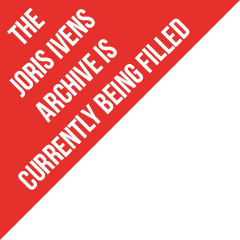

This year the Radboud University started a new course on documentary film, called Moving Documentaries. In the framework of this course a group of 15 students visited the Joris Ivens Archives and found out how archival documents can support research and shed new light on context and.content. The case study was Ivens' documentary The Spanish Earth (1937). At first the group watched the documentary in the film theater LUX on large screen. Afterwards they discussed the film and went to the Regional Archives Nijmegen, where the collection of the Joris Ivens Archives are being kept in the vaults. In these vaults the students saw how 'history' is preserved and saved for the future, like the film posters of The Spanish Earth, photos, clippings, the Bell & Howelll film camera, letters, telegrams and other correspondence between Ivens and Luis Bunuel, Ernest Hemingway, John Dos Passos and others involved in this film proudctions and film interviews with Martha Gellhorn, Helen van Dongen and Joris Ivens himself. In the study room the students worked with these materials to do research concerning major issues of documentary film.
The book of Bill Nichols On Documentary is their course book.
General information about the course:
By the end of this course, students will be able to:
- understand and contextualize the documentary as a genre in relation other genres of film.
- comprehend, critically reflect on, and analyze documentary films: their generic characteristics, poetics, production, distribution and consumption;
- critically process diverse theoretical perspectives on the genre,
- apply their skills for observing, describing, analyzing and critiquing a number of case studies;
- reflect critically on the methods and theories used in secondary sources, written samples from peers and the student's own essays.
The genre of the documentary has a long history. Although the English term was not coined before 1926, similar practices have existed since the dawn of film making. Their popularity has been increasing ever since, and in the 21st century this genre has spread across a variety of different media: traditional platforms (such as documentary television and cinema), Netflix but also social media, such as YouTube.
Documentaries are moving in several senses of the word. First, they often have a link with traveling and mobility. This link can be very explicit, as in Michael Palin’s BBC-series Travel around the World in 80 Ways (1989), or more subtle, for instance when considering the filmmaker who travels to distant times and/or places in order to tell the stories of injustices inflicted upon others, or who is driven into exile because of his/her work (like Roberto Hernández, who had to seek assylum in the Netherlands for his 2021 Netflix-documentary Reasonable Doubt: a Tale of Two Kidnappings). In a metaphorical sense, the documentary film invites us to move to a reality still unknown. Second, documentaries can move people in a literal sense, for instance when someone decides to go on a safari after watching National Geographic Channel. Third, they can also move us in an emotional sense, for instance by bringing us to tears and shocking us, as is the case with Enjoy Poverty (2009) by Renzo Martens. In doing so they often try to have an impact on people’s behavior towards the injustices unveiled, with varying degrees of success. Last, many documentaries attempt to change worldviews (and policies), by offering different interpretations of real life ‘facts’, as was the case with Davis Guggenheim’s An Inconvenient Truth (2006) on climate change, or The Revolution Will Not Be Televised (2003) by Kim Bartley and Donnacha Ó Briain, on political events in Venezuela. In doing all this, documentaries have an important impact on knowledge production in the widest sense of the word.
In this course, we will critically explore the art of the documentary film through a variety of examples of documentaries from around the world. Even if documentary films tell us stories about real life, they have a complex relation with truth and reality. Documentary filmmakers use reality as their raw material, to manipulate it into a narrative with a plot and a purpose. At the same time, these narratives are influenced by the media platforms on which they are circulated. We will analyze the complex relations between fiction and reality, (post-)truth and authenticity, engagement and objectivity, advocacy and entertainment, which are at the center of documentary filmmaking as an art and a medium.